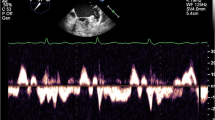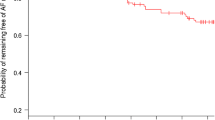Abstract
Aims
We investigated the relationship between arrhythmia burden, left atrial volume (LAV) and N-terminal pro-B-type natriuretic peptide (NT-pro-BNP) at baseline and after long-term follow-up of atrial fibrillation (AF) ablation.
Methods
We studied 38 patients (23 paroxysmal, 6 women, mean age 56 ± 11) scheduled for AF ablation. LAV was calculated on the basis of computed tomography images at baseline and long-term follow-up, and arrhythmia burden was graded from self-reported frequency and duration of AF episodes.
Results
After a mean period of 22 ± 5 months, 28/38 patients (11/15 persistent) were free from AF recurrence. At baseline there were no differences in mean LAV (125 vs. 130 cm3, p = 0.7) or median NT-pro-BNP (33.5 vs. 29.5 pmol/L, p = 0.9) between patients whose ablation had been successful or otherwise. At long-term follow-up, there was a marked decrease in LAV (105 vs. 134 cm3, p < 0.05) and level of NT-pro-BNP (7 vs. 17.5 pmol/L, p < 0.05) in the successful ablation patients. NT-pro-BNP correlated with LAV both at baseline (r = 0.71, p < 0.001) and at follow-up (r = 0.57, p < 0.001). Arrhythmia burden correlated with both NT-pro-BNP (r = 0.47, p < 0.01) and LAV (r = 0.52, p < 0.01). A decrease in NT-pro-BNP at follow-up of >25% of baseline value had a specificity of 0.89 and a sensitivity of 0.6 (receiver operator characteristics, accuracy 0.82) for ablation success.
Conclusions
NT-pro-BNP correlates with LAV and arrhythmia burden in AF patients and both NT-pro-BNP and LAV decrease significantly after successful ablation. A decrease in NT-pro-BNP of >25% from the baseline value could be useful as a marker of ablation success.



Similar content being viewed by others
References
Camm, A. J., Kirchhof, P., Lip, G. Y. H., Schotten, U., Savelieva, I., Ernst, S., et al. (2010). Guidelines for the management of atrial fibrillation. The Task Force for the Management of Atrial Fibrillation of the European Society of Cardiology (ESC). Developed with the special contribution of the European Heart Rhythm Association (EHRA). Endorsed by the European Association for Cardio-Thoracic Surgery (EACTS). Europace, 12, 1360–1420.
Haïssaguerre, M., Jaïs, P., Shah, D. C., Garrigue, S., Takahashi, A., Lavergne, T., et al. (2000). Electrophysiological end point for catheter ablation of atrial fibrillation initiated from multiple pulmonary venous foci. Circulation, 101, 1409–1417.
Chen, J., Off, M. K., Solheim, E., Schuster, P., Hoff, P. I., & Ohm, O. J. (2008). Treatment of atrial fibrillation by silencing electrical activity in the posterior inter-pulmonary-vein atrium. Europace, 10, 265–272.
Gaita, F., Caponi, D., Scaglione, M., Montefusco, A., Corleto, A., Di Monte, F., et al. (2008). Long-term clinical results of 2 different ablation strategies in patients with paroxysmal and persistent atrial fibrillation. Circulation: Arrhythmia and Electrophysiology, 1, 269–275.
Morillo, C. A., Klein, G. J., Jones, D. L., & Guiraudon, G. M. (1995). Chronic rapid atrial pacing. Structural, functional, and electrophysiological characteristics of a new model of sustained atrial fibrillation. Circulation, 91, 1588–1595.
Wijffels, M. C., Kirchhof, C. J., Dorland, R., & Allessie, M. A. (1995). Atrial fibrillation begets atrial fibrillation. A study in awake chronically instrumented goats. Circulation, 92, 1954–1968.
Kojodjojo, P., Peters, N. S., Davies, D. W., & Kanagaratnam, P. (2007). Characterisation of the electroanatomical substrate in human atrial fibrillation: the relationship between changes in atrial volume, refractoriness, wavefront propagation velocities, and AF burden. Journal of Cardiovascular Electrophysiology, 18, 269–275.
Knackstedt, C., Gramley, F., Schimpf, T., Mischke, K., Zarse, M., Plisiene, J., et al. (2008). Association of echocardiographic atrial size and atrial fibrosis in a sequential model of congestive heart failure and atrial fibrillation. Cardiovascular Pathology, 17, 318–324.
Tuinenburg, A. E., Brundel, B. J. J. M., Van Gelder, I. C., Henning, R. H., Van Den Berg, M. P., Driessen, C., et al. (1999). Gene expression of the natriuretic peptide system in atrial tissue of patients with paroxysmal and persistent atrial fibrillation. Journal of Cardiovascular Electrophysiology, 10, 827–835.
Letsas, K. P., Filippatos, G. S., Pappas, L. K., Mihas, C. C., Markou, V., Alexanian, I. P., et al. (2009). Determinants of plasma NT-pro-BNP levels in patients with atrial fibrillation and preserved left ventricular ejection fraction. Clinical Research in Cardiology, 98, 101–106.
Ellinor, P. T., Low, A. F., Patton, K. K., Shea, M. A., & MacRae, C. A. (2005). Discordant atrial natriuretic peptide and brain natriuretic peptide levels in lone atrial fibrillation. Journal of the American College of Cardiology, 45, 82–86.
Hwang, H. J., Son, J. W., Nam, B.-H., Joung, B., Lee, B., Kim, J.-B., et al. (2009). Incremental predictive value of pre-procedural N-terminal pro-B-type natriuretic peptide for short-term recurrence in atrial fibrillation ablation. Clinical Research in Cardiology, 98, 213–218.
Patton, K. K., Ellinor, P. T., Heckbert, S. R., Christenson, R. H., DeFilippi, C., Gottdiener, J. S., et al. (2009). N-terminal pro-B-type natriuretic peptide is a major predictor of the development of atrial fibrillation: the cardiovascular health study. Circulation, 120, 1768–1774.
Müller, H., Noble, S., Keller, P.-F., Sigaud, P., Gentil, P., Lerch, R., et al. (2008). Biatrial anatomical reverse remodelling after radiofrequency catheter ablation for atrial fibrillation: evidence from real-time three-dimensional echocardiography. Europace, 10, 1073–1078.
Danicek, V., Theodorovich, N., Bar-Chaim, S., Miller, A., Vered, Z., Koren-Morag, N., et al. (2008). Sinus rhythm restoration after atrial fibrillation: the clinical value of N-terminal pro-BNP measurements. Pacing and Clinical Electrophysiology, 31, 955–960.
Kurosaki, K., Tada, H., Hashimoto, T., Ito, S., Miyaji, K., Naito, S., et al. (2007). Plasma natriuretic peptide concentrations as a predictor for successful catheter ablation in patients with drug-refractory atrial fibrillation. Circulation Journal, 71, 313–320.
Jayam, V. K., Dong, J., Vasamreddy, C. R., Lickfett, L., Kato, R., Dickfeld, T., et al. (2005). Atrial volume reduction following catheter ablation of atrial fibrillation and relation to reduction in pulmonary vein size: an evaluation using magnetic resonance angiography. Journal of Interventional Cardiac Electrophysiology, 13, 107–114.
Darbar, D., & Roden, D. M. (2005). Symptomatic burden as an endpoint to evaluate interventions in patients with atrial fibrillation. Heart Rythm, 2, 544–549.
Lester, S. J., Ryan, E. W., Schiller, N. B., & Foster, E. (1999). Best methods in clinical practice and in research studies to determine left atrial size. The American Journal of Cardiology, 84, 829–832.
Hussein, A. A., Saliba, W. I., Martin, D. O., Shadman, M., Kanj, M., Bhargava, M., et al. (2011). Plasma B-type natriuretic peptide levels and recurrent arrhythmia after successful ablation of lone atrial fibrillation. Circulation, 123, 2077–2082.
Sacher, F., Corcuff, J. B., Schraub, P., Le Bouffos, V., Georges, A., Jones, S. O., et al. (2008). Chronic atrial fibrillation ablation impact on endocrine and mechanical cardiac functions. European Heart Journal, 29, 1290–1295.
Degener, S., Pattberg, S. V., Feuersenger, H., Bansmann, P. M., Shin, D. I., Krummenauer, F., et al. (2011). Predictive value of B-type natriuretic peptide levels in patients with paroxysmal and persistent atrial fibrillation undergoing pulmonary vein isolation. Journal of Interventional Cardiac Electrophysiology, 30, 217–225.
Järvinen, V. M., Kupari, M. M., Hekali, P. E., & Poutanen, V. P. (1994). Assessment of left atrial volumes and phasic function using cine magnetic resonance imaging in normal subjects. The American Journal of Cardiology, 73, 1135–1138.
Hof, I., Arbab-Zadeh, A., Scherr, D., Chilukuri, K., Dalal, D., Abraham, T., et al. (2009). Correlation of left atrial diameter by echocardiography and left atrial volume by computed tomography. Journal of Cardiovascular Electrophysiology, 20, 159–163.
Beukema, W. P., Elvan, A., Sie, H. T., Misier, A. R. R., & Wellens, H. J. J. (2005). Successful radiofrequency ablation in patients with previous atrial fibrillation results in a significant decrease in left atrial size. Circulation, 112, 2089–2095.
Reant, P., Lafitte, S., Jaïs, P., Serri, K., Weerasooriya, R., Hocini, M., et al. (2005). Reverse remodelling of the left cardiac chambers after catheter ablation after 1 year in a series of patients with isolated atrial fibrillation. Circulation, 112, 2896–2903.
Lo, L. W., Lin, Y. J., Tsao, H. M., Chang, S. L., Udyavar, A. R., Hu, Y. F., et al. (2009). The impact of left atrial size on long-term outcome of catheter ablation of chronic atrial fibrillation. Journal of Cardiovascular Electrophysiology, 20, 1211–1216.
Abecasis, J., Dourado, R., Ferreira, A., Saraiva, C., Cavaco, D., Santos, K. R., et al. (2009). Left atrial volume calculated by multi-detector computed tomography may predict successful pulmonary vein isolation in catheter ablation of atrial fibrillation. Europace, 11, 1289–1294.
Abhayaratna, W. P., Seward, J. B., Appleton, C. P., Douglas, P. S., Oh, J. K., Tajik, A. J., et al. (2006). Left atrial size. Physiologic determinants and clinical applications. Journal of the American College of Cardiology, 47, 2357–2363.
Chang, S.-H., Tsao, H.-M., Mu, M.-H., Tai, C.-T., Chang, S.-H., Wongcharoen, W., et al. (2007). Morphological changes of the left atrial appendage after catheter ablation of atrial fibrillation. Journal of Cardiovascular Electrophysiology, 18, 47–52.
Hindricks, G., Piorkowski, C., Tanner, H., Kobza, R., Gerds-Li, J. H., Carbucicchio, C., et al. (2005). Perception of atrial fibrillation before and after radiofrequency catheter ablation: relevance of asymptomatic arrhythmia recurrence. Circulation, 112, 307–313.
Acknowledgements
This study was supported by a grant from the Norwegian Foundation for Health and Rehabilitation.
Conflict of interest
Chen and Solheim received consultant fees from St. Jude Medical, and Peter Schuster was a recipient of Nordic electrophysiological research grant from Biosense Webster.
Author information
Authors and Affiliations
Corresponding author
Rights and permissions
About this article
Cite this article
Solheim, E., Off, M.K., Hoff, P.I. et al. N-terminal pro-B-type natriuretic peptide level at long-term follow-up after atrial fibrillation ablation: a marker of reverse atrial remodelling and successful ablation. J Interv Card Electrophysiol 34, 129–136 (2012). https://doi.org/10.1007/s10840-011-9629-2
Received:
Accepted:
Published:
Issue Date:
DOI: https://doi.org/10.1007/s10840-011-9629-2




